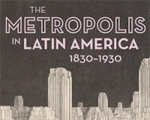The Metropolis in Latin America, 1830-1930 Opens at Americas Society
March 2, 2018
 Americas Society presents The Metropolis in Latin America, 1830-1930, an exhibition that explores the impact that a century of accelerated urbanization as well as political and social transformations had on the architectural landscapes of six Latin American capitals: Buenos Aires, Havana, Lima, Mexico City, Rio de Janeiro, and Santiago de Chile. Curated by Idurre Alonso and Maristella Casciato, The Metropolis in Latin America, 1830-1930 will be on view in the Americas Society Art Gallery at 680 Park Avenue from March 22 through June 30, 2018. The exhibition features rare maps, engravings, drawings, photographs, books, and videos that range from Hernán Cortés’ Map of Tenochtitlán (1524) to Le Corbusier’s drawings of the City of Buenos Aires (1929).
Americas Society presents The Metropolis in Latin America, 1830-1930, an exhibition that explores the impact that a century of accelerated urbanization as well as political and social transformations had on the architectural landscapes of six Latin American capitals: Buenos Aires, Havana, Lima, Mexico City, Rio de Janeiro, and Santiago de Chile. Curated by Idurre Alonso and Maristella Casciato, The Metropolis in Latin America, 1830-1930 will be on view in the Americas Society Art Gallery at 680 Park Avenue from March 22 through June 30, 2018. The exhibition features rare maps, engravings, drawings, photographs, books, and videos that range from Hernán Cortés’ Map of Tenochtitlán (1524) to Le Corbusier’s drawings of the City of Buenos Aires (1929).
Previously on view at The Getty Research Institute in Los Angeles, The Metropolis in Latin America, 1830-1930 documents the radical breaks with the colonial past, transformative architectural exchanges with Europe and beyond, and the subsequent reinterpretation of pre-Hispanic, Spanish, and Portuguese motifs that influenced the emergence of a modernist culture in Latin America.
“The juncture that followed the processes of independence from Mexico to Argentina triggered a myriad of local initiatives that led to the re-organization of the cities from the newly freed republics to the nation-states before the Second World War,” explained Americas Society Visual Arts Director and Chief Curator Gabriela Rangel. “Metropolis is an effort that reveals the importance of archival research within a period that has been mostly overseen in the U.S. scholarship on Latin America.”
“Following independence, Latin Americans had an urgent desire to break with the colonial past. This desire was expressed through architecture and urban planning, among other ways,” said exhibition curator Maristella Casciato. “Over a time of intense growth and social change, cities began to reshape themselves, removing or diminishing the power of colonial symbols through the construction of new civic buildings.”
“During the sixteenth century and for the next three centuries, town planning became a key tool for the colonial enterprise guiding the development of commercially functional and militarily strategic cities,” commented exhibition curator Idurre Alonso. “This exhibition traces the changes of six major capitals as independence, industry, and exchange of ideas altered their built environments and eventually transformed them into newly monumental, modern metropoles.”
Until about 1850, cities in Latin America maintained most of their colonial structures. The eventual adoption of modern architectural repertoires fostered the removal of symbols of colonial power and the construction of new civic buildings emphasizing each country’s own new self-view. By the later part of the nineteenth century significant changes, including massive migration to cities and the beginning of local industrialization, resulted in new urban development. However, the legacy of the colonial city was still visible.
In the 1910s, grand celebrations across Latin America marked 100 years of independence. These commemorations, which coincided with the end of World War I and a significant increase in immigration from Europe, sparked a reconsideration of national identity and a return to local architectural traditions. Later, a new generation of Latin American designers imagined utopian visions of the metropolis in modern ways.
Learn more about the exhibition.





























